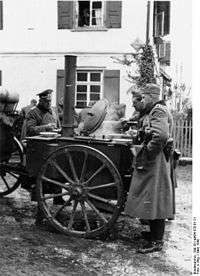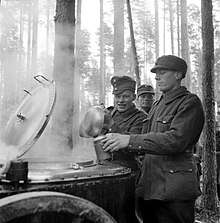Field kitchen
A field kitchen is a mobile kitchen, mobile canteens or food truck used primarily by military services to provide warm food to the troops near the frontline or in temporary encampments.

Description
The first field kitchens were carried in four-wheeled wagons by military units on campaign throughout history. Indeed, this method of feeding a large travelling group of people was often used, such as on the Wagon Trail in late 19th Century America where the Chuckwagon was employed. By the 20th Century, smaller two-wheeled trailers, became common, especially with the invention of locomotive travel. Field Kitchens were often given affectionate nicknames.

Karl Rudolf Fissler of Idar-Oberstein invented a mobile field kitchen in 1892 that the Germans came to refer to as a Gulaschkanone (Goulash Cannon) because the chimney of the stove resembled ordnance pieces when disassembled and limbered for towing. As technology has advanced, larger trailers have evolved as horses were phased out in favour of motorized vehicles more capable of towing heavier loads. In WWII the mobile canteen was used as a morale booster in the United Kingdom, fitting in with the culture of the tea break and in particular as a result of the successful wartime experiment of the tea lady on productivity and morale.[1] The larger mobile kitchens (now commonly called "flying kitchens" because of the greater speed with which they can be deployed) can service entire battalions of troops.
Gallery
- German field kitchen at the Australian War Memorial
 Austro-Hungarian carriers bringing food into trenches during WWI
Austro-Hungarian carriers bringing food into trenches during WWI Finnish soldiers gathering breakfast from a field kitchen before the Winter War
Finnish soldiers gathering breakfast from a field kitchen before the Winter War
References
| Wikimedia Commons has media related to Field kitchens. |
- "Your Mobile Canteen in Action". Imperial War Museum. Retrieved 2010-07-25.
